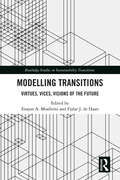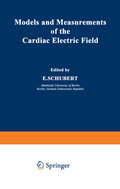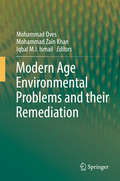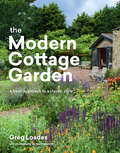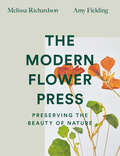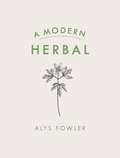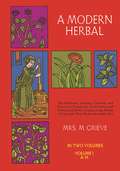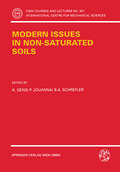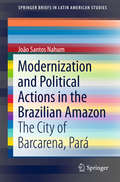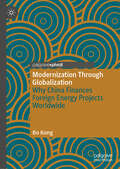- Table View
- List View
Modelling Rock Fracturing Processes: Theories, Methods, and Applications
by Baotang Shen Ove Stephansson Mikael RinneThis book is the second edition of the well-known textbook Modelling Rock Fracturing Processes. The new and extended edition provides the theoretical background of rock fracture mechanics used for modelling of 2-D and 3-D geomechanics problems and processes. Fundamentals of rock fracture mechanics integrated with experimental studies of rock fracturing processes are highlighted. The computer programs FRACOD 2D and 3D are used to analyse fracture initiation and propagation for the three fracture modes: Mode I, II and III. Coupled fracture modelling with other continuous and distinct element codes including FLAC, PFC, RFPA, TOUGH are also described. A series of applications of fracture modelling with importance for modern society is presented and discussed by distinguished rock fracture modelling experts.
Modelling Soil Erosion by Water (Nato ASI Subseries I: #55)
by DavidFavis-Mortlock JohnBoardmanTO THE MODEL EVALUATION 1. MODELLING SOIL EROSION BY WATER l 2 John Boardman and David Favis-Mortlock 1 School of Geography and Environmental Change Unit Mansfield Road University of Oxford Oxford OX1 3TB UK 2 Environmental Change Unit University of Oxford 5 South Parks Road Oxford OX1 3UB UK Introduction This volume is the Proceedings of the NATO Advanced Research Workshop 'Global Change: Modelling Soil Erosion by Water', which was held on II-14th September 1995, at the University of Oxford, UK. The meeting was also one of a series organised by the IGBP 1 GCTE Soil Erosion Network, which is a component of GCTE's Land Degradation Task (3.3.2) (Ingram et aI., 1996; Valentin, this volume). One aim of the GCTE Soil Erosion Network is to evaluate the suitability of existing soil erosion models for predicting the possible impacts of global change upon soil erosion. Due to the wide range of erosion models currently, in use or under development, it was decided to evaluate models in the following sequence Favis-Mortlock et al., 1996): • field-scale water erosion models • catchmenr-scale water erosion models • wind erosion models • models with a landscape-scale and larger focus. As part of this strategy, the first stage of the GCTE validation of field-scale erosion models was carried out at the Oxford NATO-ARW. I A list of Acronyms fonns Appendix A.
Modelling the Socio-Economic Implications of Sustainability Issues in the Housing Market: A Stated Choice Experimental Approach
by Solomon Pelumi Akinbogun Clinton Aigbavboa Trynos Gumbo Wellington ThwalaThis book discusses sustainable housing issues in urban areas throughout the Global South, revealing their complexity in terms of urban dynamics, housing markets and human interactions with the environment. Its main focus is on the location of graves within private residences, cemeteries in the immediate vicinity of private residences, and the implications of these factors for renters’ choices and rents. The book addresses the economics of land use for graves in connection with housing choices and the implications for the rented sector of the property market. By means of several model-based simulations, it demonstrates that the neoclassical economics remedy to the negative externality of graves in or near private residences remains generally unacceptable. Providing readers with a clear understanding of tenants’ priorities in their choice of housing, as well as a new approach to the negative externality of graves in the rented sector, the book will be of interest to policymakers, urban planners, investors in residential housing and land economists alike.
Modelling Transitions: Virtues, Vices, Visions of the Future (Routledge Studies in Sustainability Transitions)
by Enayat A. Moallemi Fjalar J. de HaanModelling Transitions shows what computational, formal and data-driven approaches can and could mean for sustainability transitions research, presenting the state-of-the-art and exploring what lies beyond. Featuring contributions from many well-known authors, this book presents the various benefits of modelling for transitions research. More than just taking stock, it also critically examines what modelling of transformative change means and could mean for transitions research and for other disciplines that study societal changes. This includes identifying a variety of approaches currently not part of the portfolios of transitions modellers. Far from only singing praise, critical methodological and philosophical introspection are key aspects of this important book. This book speaks to modellers and non-modellers alike who value the development of robust knowledge on transitions to sustainability, including colleagues in congenial fields. Be they students, researchers or practitioners, everyone interested in transitions should find this book relevant as reference, resource and guide.
Modelling Transitions: Virtues, Vices, Visions of the Future (Routledge Studies in Sustainability Transitions)
by Enayat A. Moallemi Fjalar J. De HaanModelling Transitions shows what computational, formal and data-driven approaches can and could mean for sustainability transitions research, presenting the state-of-the-art and exploring what lies beyond. Featuring contributions from many well-known authors, this book presents the various benefits of modelling for transitions research. More than just taking stock, it also critically examines what modelling of transformative change means and could mean for transitions research and for other disciplines that study societal changes. This includes identifying a variety of approaches currently not part of the portfolios of transitions modellers. Far from only singing praise, critical methodological and philosophical introspection are key aspects of this important book. This book speaks to modellers and non-modellers alike who value the development of robust knowledge on transitions to sustainability, including colleagues in congenial fields. Be they students, researchers or practitioners, everyone interested in transitions should find this book relevant as reference, resource and guide.
Modelling water and nutrient dynamics in soil-crop systems: Applications of different models to common data sets - Proceedings of a workshop held 2004 in Müncheberg, Germany
by K. Ch. Kersebaum Jens-Martin Hecker W. Mirschel Martin WegehenkelThis book contains articles from a workshop on the modeling of water and nutrient dynamics in crop-soil systems. Data sets from lysimeters and experimental fields of multiyear crop rotations were provided for modelers. A unique data set is provided of a 100-year, long-term field experiment into crop yield and organic carbon development under different management systems. The book includes a detailed description of data sets which can be used by modelers and the papers describe the applications of 18 different modeling approaches.
Models and Measurements of the Cardiac Electric Field
by E. SchubertThe electric field of the heart was described diagrammatically for the first time by A. Waller in 1888. However, it was not until a little more than ten years ago that with the development of micro electronic techniques, it became accessible to biophysical modeling, to exact physiological measurements, and to application in advanced clinical diagnosis. These possibilities opened the way to the treatment of questions which are called the direct and the inverse solution of the cardioelectric problem. Several groups of investigators are now working to achieve a complete biophysical and physiological description of the generation of the cardiac electric field. This work could well form the basis for a new method of diagnostic measurements, with applications even in clinical cardiology, delivering important information by a non invasive investigation of the patient. Several conferences have stimulated international exchange of the results of research on the cardiac electric field. Among others, the satellite symposium of the XXV International Congress of Physio logical Sciences on the electric field of the heart, in Brussels, August 2-3, 1971, and the Conference on Measuring and Modeling of the cardiac electric field, in Smolenice near Bratislava, June 14- 17, 1976, may be considered predecessors of the Dresden symposium the proceedings of which are presented in this volume.
Models of Tree and Stand Dynamics: Theory, Formulation and Application
by Annikki Mäkelä Harry T. ValentineThe book is designed to be a textbook for university students (MSc-PhD level) and a reference for researchers and practitioners. It is an introduction to dynamic modelling of forest growth based on ecological theory but aiming for practical applications for forest management under environmental change. It is largely based on the work and research findings of the authors, but it also covers a wide range of literature relevant to process-based forest modelling in general. The models presented in the book also serve as tools for research and can be elaborated further as new research findings emerge. The material in the book is arranged such that the student starts from basic concepts and formulations, then moves towards more advanced theories and methods, finally learning about parameter estimation, model testing, and practical application. Exercises with solutions and hands-on R-code are provided to help the student digest the concepts and become proficient with the methods. The book should be useful for both forest ecologists who want to become modellers, and for applied mathematicians who want to learn about forest ecology. The basic concepts and theory are formulated in the first four chapters, including a review of traditional descriptive forest models, basic concepts of carbon balance modelling applied to trees, and theories and models of tree and forest structure. Chapter 5 provides a synthesis in the form of a core model which is further elaborated and applied in the subsequent chapters. The more advanced theories and methods in Chapters 6 and 7 comprise aspects of competition through tree interactions, and eco-evolutionary modelling, including optimisation and game theory, a topical and fast developing area of ecological modelling under climate change. Chapters 8 and 9 are devoted to parameter estimation and model calibration, showing how empirical and process-based methods and related data sources can be bridged to provide reliable predictions. Chapter 10 demonstrates some practical applications and possible future development paths of the approach. The approach in this book is unique in that the models presented are based on ecological theory and research findings, yet sufficiently simple in structure to lend themselves readily to practical application, such as regional estimates of harvest potential, or satellite-based monitoring of growth. The applicability is also related to the objective of bridging empirical and process-based approaches through data assimilation methods that combine research-based ecological measurements with standard forestry data. Importantly, the ecological basis means that it is possible to build on the existing models to advance the approach as new research findings become available.
Modern Age Environmental Problems and their Remediation
by Mohammad Oves Mohammad Zain Khan Iqbal M.I. IsmailThis book presents a novel picture in current advances in research of theoretical and practical frameworks of environmental problems and solutions taken from the latest empirical research findings.The book deals with basic concepts and principles of process, modern biochemical and molecular approaches, genomics and metagenomics, proteomics, remediation strategies of various hazardous pollutants, microbial carbon sequestration and remediation, phytoremediation, bioleaching, biosorption, upscaling of systems, and considers the merit and demerits based on the current literature related to environmental problems and solutions. The book is aimed at professionals, researchers, academicians, and students who would like to improve their understanding of the strategic role of environment protection and advanced applied technologies at different levels. It will be useful for the experienced engineer or scientist working in the field.
Modern Agriculture and the Environment: Proceedings of an International Conference, held in Rehovot, Israel, 2–6 October 1994, under the auspices of the Faculty of Agriculture, the Hebrew University of Jerusalem (Developments in Plant and Soil Sciences #71)
by David Rosen E. Tel-Or Y. Hadar Y. ChenThis volume comprises the proceedings of the First International Rehovot Conference on Modem Agriculture and the Environment, held at the Rehovot Campus of the Faculty of Agriculture, the Hebrew University of Jerusalem, Israel, 2-6 October 1994. The conference, first in a series intended to be convened in Rehovot at 4-5 year intervals to address various aspects of the interaction of agriculture and the environment, was initiated, organised and carried out under the auspices of the Faculty of Agriculture, the leading academic institution in agricultural and environmental studies in Israel. It featured four keynote addresses, 39 invited lectures, 40 submitted papers, and 62 posters. Of these, 51 articles, written by 122 contributing authors from 14 countries, were selected by the editors to be presented in this book. All through the twentieth century, and especially ever since the advent of the Green Revolution, modem agriCUlture has been striving to feed and clothe the ever increasing multitudes of the human species through improved technology, relying heavily on tremendous inputs of fertilisers, pesticides, and various other agrochemicals. Undoubtedly, this has been a great blessing to mankind, and enormous strides have indeed been made in the never-ending struggle against starvation, but these have been achieved at a very steep price of increased environmental deterioration. In fact, modem agriculture has become one of the major factors contributing to the degradation of the world's fragile biosphere.
The Modern Cottage Garden: A Fresh Approach to a Classic Style
by Greg LoadesThis design-forward guide teaches gardeners how to blend the best aspects of two important styles: the traditional cottage garden and the New Perennial movement.
Modern Fiction, Disability, and the Hearing Sciences (Routledge Interdisciplinary Perspectives on Literature)
by Edward AllenThe relationship between critical disability studies and the hearing sciences is a dynamic one, and it’s changing still, both as clinicians come to terms with the evolving health of deaf and hearing communities and as the ‘social’ and ‘medical’ understandings of disability continue to gain traction among different groups. What might a ‘cultural’ approach to these overlapping areas of study involve? And what could narrative prose in particular have to tell us that other sources haven’t sensed?At a time when visual media otherwise seem to have captured the imagination, Modern Fiction, Disability, and the Hearing Sciences makes the case for a wide range of literature. In doing so – through serials, short stories, circadian fiction, narrative history, morality tales, whodunits, Bildungsromane, life-writing, the Great American Novel – the book reveals the diverse ways in which writers have plotted and voiced experiences of hearing, from the nineteenth century to the present day.
Modern Fiction, Disability, and the Hearing Sciences (Routledge Interdisciplinary Perspectives on Literature)
The relationship between critical disability studies and the hearing sciences is a dynamic one, and it’s changing still, both as clinicians come to terms with the evolving health of deaf and hearing communities and as the ‘social’ and ‘medical’ understandings of disability continue to gain traction among different groups. What might a ‘cultural’ approach to these overlapping areas of study involve? And what could narrative prose in particular have to tell us that other sources haven’t sensed?At a time when visual media otherwise seem to have captured the imagination, Modern Fiction, Disability, and the Hearing Sciences makes the case for a wide range of literature. In doing so – through serials, short stories, circadian fiction, narrative history, morality tales, whodunits, Bildungsromane, life-writing, the Great American Novel – the book reveals the diverse ways in which writers have plotted and voiced experiences of hearing, from the nineteenth century to the present day.
The Modern Flower Press: Preserving The Beauty Of Nature
by Melissa Richardson Amy FieldingA contemporary, beautifully illustrated book on flowers, flower pressing and arranging.
A Modern Guide to Knowledge: From Knowledge Economies to Knowledge in the Anthropocene (Elgar Modern Guides)
by Francisco J. CarrilloOutlining an integrative theory of knowledge, Francisco Javier Carrillo explores how to understand the underlying behavioural basis of the knowledge economy and society. Chapters highlight the notion that unless a knowledge-based value creation and distribution paradigm is globally adopted, the possibilities for integration between a sustainable biosphere and a viable economy are small.This Modern Guide provides an overview of where we are regarding the knowledge economy and society, how its current form took shape and how our understanding has evolved, from the grounds of the philosophy of knowledge, to include the current branches of the sciences of knowledge. Carrillo further examines the challenges of the Anthropocene and how modern knowledge systems might need to change radically to meet them. The Modern Guide then moves to focus on the integration of epistemic, theoretical, technical and political developments in several fields of knowledge-related aspects of economy and society to offer a more integrated view.>Multidisciplinary and thorough, this will be an interesting read for scholars of knowledge, society and the environment, as well as students looking at ways to re-evaluate knowledge more broadly. Policymakers and governmental analysts will also benefit from the discussing of the unviability of our current economic culture and the potential options for the future.
A Modern Herbal
by Alys FowlerPlant-based medicine for a calmer, healthier life It's easy to turn to the pharmacy when we're stressed, sick or feeling under the weather, but what if you turned to your garden instead?In this accessible and easy to use manual, horticultural expert, former Gardener's World presenter and Guardiancolumnist, Alys Fowler, shows how to take control of your health by adopting a more natural lifestyle. For thousands of years, people who had no access to clinical medicine knew how to boost their well-being by using the ingredients they found in plants. Herbs are the people's medicine; often freely available and abundant, they are ready and waiting to be plucked from around you to soothe and heal your body and mind. With guides for how to use and grow over 100 herbs - for example how to use fennel for indigestion, camomile for anxiety and nettle for hayfever - you'll soon be heading into the garden, rather than opening the medicine cabinet. Offering a fusion of botanical, practical, cultural and historical information, A Modern Herbal reveals how common herbs are the simple, cleansing way to better health and happiness.AS SEEN IN THE GUARDIAN
A Modern Herbal
by Margaret GrieveIf you want to know how pleurisy root, lungwort, and abscess root got their names, how poison ivy used to treat rheumatism, or how garlic guarded against the Bubonic Plague, consult A Modern Herbal. This 20th-century version of the medieval Herbal is as rich in scientific fact and folklore as its predecessors and is equally encyclopedic in coverage. From aconite to zedoary, not an herb, grass, fungus, shrub or tree is overlooked; and strange and wonderful discoveries about even the most common of plants await the reader.Traditionally, an herbal combined the folk beliefs and tales about plants, the medicinal properties (and parts used) of the herbs, and their botanical classification. But Mrs. Grieve has extended and enlarged the tradition; her coverage of asafetida, bearberry, broom, chamomile, chickweed, dandelion, dock, elecampane, almond, eyebright, fenugreek, moss, fern, figwort, gentian, Hart's tongue, indigo, acacia, jaborandi, kava kava, lavender, pimpernel, rhubarb, squill, sage, thyme, sarsaparilla, unicorn root, valerian, woundwort, yew, etc. — more than 800 varieties in all — includes in addition methods of cultivation; the chemical constituents, dosages, and preparations of extracts and tinctures, unknown to earlier herbalists; possible economic and cosmetic properties, and detailed illustrations, from root to bud, of 161 plants.Of the many exceptional plants covered in Herbal, perhaps the most fascinating are the poisonous varieties — hemlock, poison oak, aconite, etc. — whose poisons, in certain cases, serve medical purposes and whose antidotes (if known) are given in detail. And of the many unique features, perhaps the most interesting are the hundreds of recipes and instructions for making ointments, lotions, sauces, wines, and fruit brandies like bilberry and carrot jam, elderberry and mint vinegar, sagina sauce, and cucumber lotion for sunburn; and the hundreds of prescriptions for tonics and liniments for bronchitis, arthritis, dropsy, jaundice, nervous tension, skin disease, and other ailments. 96 plates, 161 illustrations.
Modern Issues in Non-Saturated Soils (CISM International Centre for Mechanical Sciences #357)
by A. Gens P. Jouanna B. A. SchreflerCoupling phenomena in non-saturated soils are fast becoming a headache for at least one of the following reasons: the large number of equations and unknowns, the complex T.H.M. behaviour of the soils, the sophisticated instrumentation required and/or the numerical instability encountered. If this is precisely your headache, read about the problem - and solutions to it - in "Modern Issues in Non-Saturated Soils”.
The Modern Problems of Electrostatics with Applications in Environment Protection (NATO Science Partnership Subseries: 2 #63)
by Ion I Inculet Florin Teodor Tanasescu Radu CramariucAmong the many technological and legal efforts being made to restore our environment, electrostatic technologies may well hold the solution to the cleaning of air, water and soil. Such technologies include non-thermal plasma processing - electron beam irradiation, electrical discharge, hybrid plasma systems. The book also contains descriptions of the industrial implementation of the technology for NOx and SO2 removal using accelerated electrons. This technique has been implemented in three plants, built in China, Poland and Japan. Water pollution can be controlled and reduced by the use of ozone and UV irradiation. Soil pollution can be reduced by electrical methods and by using electrostatics to spray agricultural pesticides. Further articles cover the future of EHD systems in environmental protection, new aspects of ESD research, and industrial waste recycling technologies.
Modern Religious Druidry: Studies in Paganism, Celtic Identity, and Nature Spirituality (Palgrave Studies in New Religions and Alternative Spiritualities)
by Ethan Doyle White Jonathan WoolleyOver the past three decades, the academic study of modern Paganism has gone from strength to strength. Scholars now have access to a plethora of studies available on such new religions as Wicca, Heathenry, and the Goddess Movement - but despite its prominence, modern Druidry has been much neglected. This book seeks to change that. This volume is interdisciplinary in basis, bringing together contributions from anthropologists, historians, and scholars of religion. It fundamentally deepens collective scholastic understandings of modern religious Druidry as an actor within the broader Pagan milieu. In addition to looking at the movement in various national contexts, the volume also explores thematic topics that have largely been neglected before. It will serve as a benchmark upon which all future studies of modern Druidry, as well as modern Paganism more widely, can draw upon, thereby making a particularly important and much-needed contribution to the field.
Modernism and Its Environments (New Modernisms)
by Michael Rubenstein Justin NeumanModernism and Its Environments surveys new developments in modernist studies inspired by ecocriticism and the environmental humanities. Taking a fresh view of familiar topics in modernist studies such as the city, this book also introduces new topics and perspectives on modernism, such as: nature and wilderness; conservation and preservation; energy and fuel; waste and pollution; the animal and the human; and weather and climate. Ecocritical and environmentalist approaches have fundamentally altered our understanding of both modernism and the field of modernist studies. This book accounts for the transformation, and offers readers a host of resources with which to continue exploring and rethinking.Covering a wide range of writers and artists including Edvard Munch, Paul Valéry, Robert Musil, A.A. Milne, Virginia Woolf, James Joyce, T.S. Eliot, J.R.R. Tolkien, Richard Wright, Elizabeth Bishop, Ralph Ellison, Olafur Eliasson, Zadie Smith, and Kate Tempest,
Modernism and Its Environments (New Modernisms)
by Michael Rubenstein Justin NeumanModernism and Its Environments surveys new developments in modernist studies inspired by ecocriticism and the environmental humanities. Taking a fresh view of familiar topics in modernist studies such as the city, this book also introduces new topics and perspectives on modernism, such as: nature and wilderness; conservation and preservation; energy and fuel; waste and pollution; the animal and the human; and weather and climate. Ecocritical and environmentalist approaches have fundamentally altered our understanding of both modernism and the field of modernist studies. This book accounts for the transformation, and offers readers a host of resources with which to continue exploring and rethinking.Covering a wide range of writers and artists including Edvard Munch, Paul Valéry, Robert Musil, A.A. Milne, Virginia Woolf, James Joyce, T.S. Eliot, J.R.R. Tolkien, Richard Wright, Elizabeth Bishop, Ralph Ellison, Olafur Eliasson, Zadie Smith, and Kate Tempest,
Modernization and Political Actions in the Brazilian Amazon: The City of Barcarena, Pará (SpringerBriefs in Latin American Studies)
by João Santos NahumThis book offers an analysis of the territory of Barcarena, in the Brazilian Amazon. The author studies the land use and the implemented modernization policies that made it one of the richest cities of the state. The political system uses this territory as a resource to provide for the needs of a small circle of social agents. A system of conservative political actions enforces the process of modernization of the Baracena territory. Innovations in the Barcarena territory, such as the implementation of the aluminium factory Albras/Alunorte and the territorial configuration or public administration, lead to modernization simulations and artificial devices. The intended effect however is more about appearing to be modern, than actual modernization. The territorial use of Barcarena is aimed to protect the interests and privileges of the elite.
Modernization Through Globalization: Why China Finances Foreign Energy Projects Worldwide
by Bo KongThis pivot considers how China deals with the globalization of its energy companies in the face of global efforts to combat climate change. It examines how China, following its emergence as the world’s largest energy consumer and its resultant growing dependence on foreign energy, engages the world on energy, and its implications for global governance of energy. It notably focuses on the policy impact of China’s global engagement for the accelerated “going out” strategy and the so-called “one belt one road” (OBOR) initiative, and profound climate implications for the rest of the world, contending that the type of energy services, technologies, and infrastructure China finances around the globe today will determine the global community’s carbon footprint in the foreseeable future.
Modes of Governance and Revenue Flows in African Mining (International Political Economy Series)
by Bonnie K. CampbellAcademics, policy-makers and practitioners from Africa and beyond document new ways of thinking about issues concerning governance and revenue flows in mining activities in Ghana, Mali and the Democratic Republic of the Congo.



